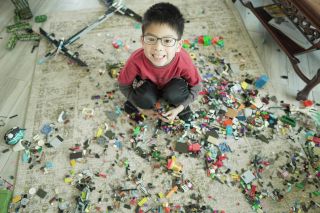Child Development
Are Fewer Toys Better for Your Toddler?
Does the number of toys affect a child's quality of play? Yes.
Posted March 13, 2024 Reviewed by Ray Parker
Key points
- The number of toys in a toddler's environment influences their quality of play.
- If fewer toys are present, children play with them longer and in more imaginative ways.
- Higher numbers of toys distract children and encourage them to move from one to another, not focusing on any.
- Having too many toys may be a form of childhood overindulgence.
I think almost everyone has seen it, especially at Christmas or perhaps at a birthday party. A child gets a staggering number of presents and begins to open them. It becomes a race, ripping the wrapping off of each present and finally getting to the last one. Not spending significant time or attention with any specific toy, the child asks, "Is this all there is?"
This raises an interesting question: Does the number of toys affect the amount of time a young child spends playing with each toy and the quality of play with each toy?
Influence of the Number of Toys in the Environment on Toddler's Play

To test the hypothesis that an environment with fewer toys would lead to a higher quality of play, Dauch and colleagues (2018) crafted a clever laboratory study. The researchers recruited 36 toddlers ages 18 and 30 months and their parents. The participants came from similar socioeconomic backgrounds and had typical development of personal-social, motor, and cognitive skills.
Thirty-two different toys were used in this study. The toys came from four categories of toys: (1) educational (shapes, colors, counting), (2) pretend (toys that suggest themed play), (3) action (building, stacking, opening, twisting), and (4) vehicles (toys that the child has to push). Data collection took place in two similar playrooms.
Toy Play Conditions and Data Collection
There were two conditions for toy play: a four-toy and a 16-toy condition. Toys were randomly selected from the four categories of toys and assigned to the four or 16 toy conditions. Each toddler and caregiver attended three one-hour sessions in which observers collected data. They recorded three types of data.
- The number of times the toddler played with a toy.
- The total amount of time the toddler played with a toy.
- The different manners and types of play with each toy (e.g., drumming, dumping, exploring, pretending, matching, gathering, or inserting).
Results
They found a significant difference in the quality of the toddlers' play when there were four versus 16 toys. Toddlers in the four-toy condition engaged in a greater quality of play compared to the 16-toy condition. In the four toy conditions, the toddlers:
- Played with fewer toys.
- Played for longer periods and more in-depth with each toy.
- Played in more imaginative ways with each toy.
Dauch and colleagues (2018) concluded that fewer toys improved the quality of play, while a greater number of toys (16 compared to four) seemed to be a distraction, which caused the toddlers to abandon play with a toy to explore the others.
Control over attention is a key skill children need to master. Too many toys create distractions. Toddlers played twice as long with toys in the four versus the 16-toy condition and more imaginative ways.
Is Having Too Many Toys Overindulgence?
"The average number of toys in participants’ environments was nearly 90 toys, with some parents unable to quantify and simply reporting 'a lot’" (Dauch et al.). The study's results support what Clarke and colleagues (2014) call childhood overindulgence.
Their research identified three types of overindulgence: giving too much, over-nurturing, and too little structure. Having too much can come not only in material possessions but can also be seen when parents schedule children for too many activities. Toys, clothes, privileges, entertainment, sports, and camps all fall under the category of giving too much. These three types of overindulgence can interact to affect child development.
Less is more when it comes to toys, that is.
Practice Aloha. Do all things with love, grace, and gratitude.
© 2024 David J. Bredehoft
References
Clarke, J. I., Dawson, C., Bredehoft, D. J. (2014). How much is too much? Raising likeable, responsible, respectful children - from toddlers to teens - in an age of overindulgence. NY: Da Capo Lifelong press.
Dauch, C., Imwalle, M., Ocasio, B., & Metz, A. E. (2018). The influence of the number of toys in the environment on toddlers’ play. Infant Behavior and Development, 50, 78-87. https://doi.org/10.1016/j.infbeh.2017.11.005


